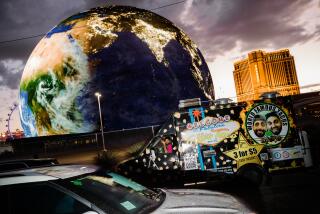Little Phish Grows Larger but Still Prefers Small Ponds
- Share via
Heard the one about the Vermont bar band that became one of the country’s top touring acts?
The first gig by Phish, at Nectar’s in Burlington, Vt., drew exactly one person.
Last year, Phish grossed $16.5 million in 50 shows, including the largest single concert date in North America, drawing 135,000 at the Clifford Ball in upstate New York--all for a band that’s never had a Top 40 hit.
In August, in a more remote location on the Canadian border in Maine, Phish managed to draw 60,000 to a weekend event.
Phish, now honored with its own Ben & Jerry’s flavor, is the one American band that could sell out stadiums. But the band--made up of guitarist Trey Anastasio, bassist Mike Gordon, keyboardist Page McConnell and drummer John Fishman--has refused to go that route.
The latest album from the band, “Slip Stitch and Pass,” was recorded in concert--but not at one of its mega-events in front of thousands of fans who know every note.
Instead, it was from a live show at a club in Germany in March.
“We seem to have come full circle,” Anastasio says in press materials that accompany the album. “A couple of the covers are songs we did at our first gig. Yet at the same time there’s been a lot of progression. This album really tells the whole story.”
Recorded at a 1,100-capacity club in Hamburg, the set is being hailed by those who never even liked the band. “Look Who Stopped Sucking!” read the headline of a Village Voice review last month.
The gig included a version of the Talking Heads’ “Cities,” ZZ Top’s “Jesus Just Left Chicago” and the barbershop quartet favorite (turned Michigan J. Frog theme song) “Hello, My Baby.”
But there is also the lounge style of one of Phish’s oldest songs, “Lawn Boy,” amid the first official recording of “Mike’s Song” and “Weekapaug Groove.” Snippets of the Doors’ “The End” emerge, as does Pink Floyd’s “Careful With That Axe, Eugene” and the Rolling Stones’ “Can’t You Hear Me Knocking.”
“The whole mood was pretty loose,” Anastasio says. “But on a bigger scale, we were going through a transition in which we were trying to change musically. We tried to break through to a different kind of jamming: slower, more groove-oriented. We were trying for genuine group interaction that was less solo-oriented. Slow and spacious, with each note really having a purpose. I think when we went over to Europe, playing in these little clubs, that change occurred without us even really noticing it.”
Gordon, in an interview posted on the band’s Web site, says the recording “represents what we feel is a new era for the band . . . where our jamming is sort of funkier and less crescendo-oriented and more just playing funky grooves for long periods of time.”
By contrast, the previous live album, “A Live One,” represented the kind of jams they were doing earlier this decade. It was epitomized by “Tweezer,” recorded in Bangor, Maine, the night after they performed, with some fanfare, the whole of the Beatles’ “White Album” as part of an annual Halloween exercise.
The approach of those jams--”which was going off in a lot of different directions with different little ideas running through it,” as Gordon describes it--ended with the big shows in Boston last New Year’s Eve.
Away from the increasing hype of their U.S. shows, the band learned to discover itself in the smaller European gigs.
“I mean, take away everything and put us in a bar in front of 300 people in the middle of a really fun tour where we’re just getting away from the whole bigness and everything of what’s happened to us in the last three years, all expectations,” Anastasio says in an interview at the band’s Web site. “And we’re over there, and we’re just hanging out and going out on the bus, having a great time, and then when I listen to the album, I’m like, wow, in a funny way this is really who we are more than any of the albums, I think.”
More to Read
The biggest entertainment stories
Get our big stories about Hollywood, film, television, music, arts, culture and more right in your inbox as soon as they publish.
You may occasionally receive promotional content from the Los Angeles Times.








